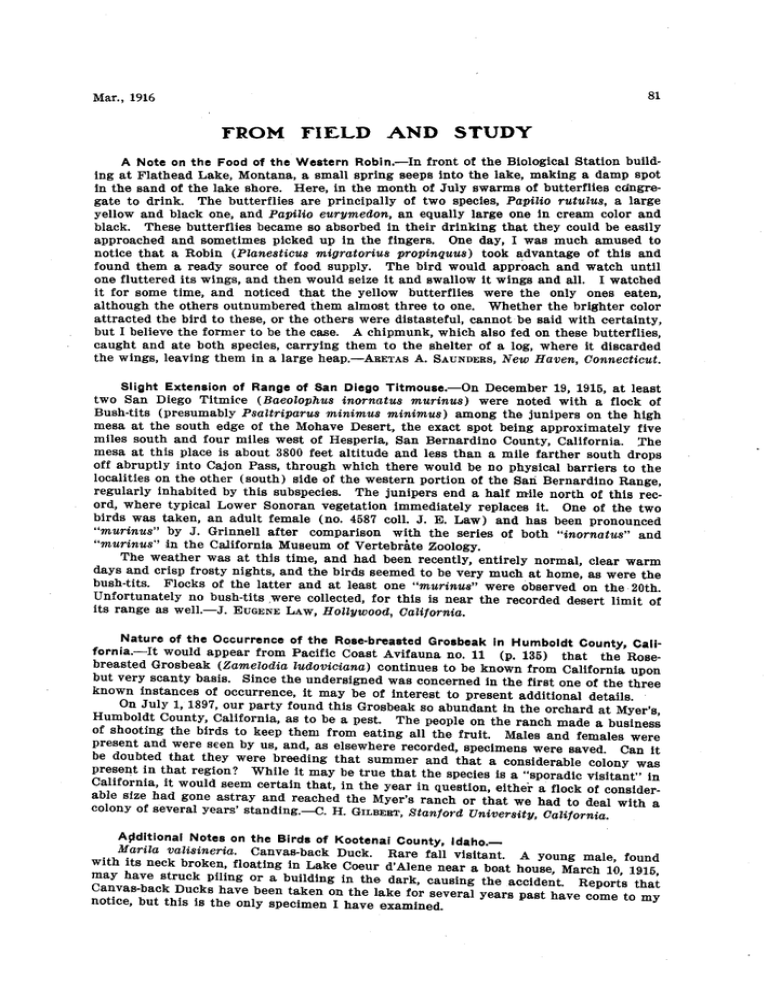Additional Notes on the Birds of Kootenai County, Idaho
advertisement

81 Mar., 1916 FROM FIELD AND STUDY A Note on the Food of the Western Robin.- In front of the Biological Station building at Flathead Lake, Montana, a small spring seeps into the lake, making a damp spot in the sand of the lake shore. Here, in tbe month of July swarms of butterflies Cangregate to drink. The butterflies are principally of two species, papilio rutulua, a large yellow and black one, and Papilio eurymedon, an equally large one in cream color and black. These butterflies became so absorbed in their drinking that they could be easily approached and sometimes picked up in the fingers. One day, I was much amused to notice that a Robin (Planesticus migratorius propinquus) took advantage of this and found them a ready source of food supply. The bird would approach and watch until one fluttered its wings, and then would seize it and swallow it wings and all. I watched it for some time, and noticed that the yellow butterflies were the only ones eaten, although the others outnumbered them almost three to one. Whether the brighter color attracted the bird to these, or the othess were distasteful, cannot be said with certainty, but I believe the former to be the case. A chipmunk, which also fed on these butterflies, caught and ate both species, carrying them to the shelter of a log, where it discarded the wings, leaving them in a large heap.- ABETAS A. SAUNDERS, New Haven, Connecticut. Slight Extension of Range of San Diego Titmouse.-On December 19, 1916, at least two San Diego Titmice (Baeolophus inornatus murinus) were noted with a flock of Bush-tits (presumably Psaltriparus minimus minimus) among the junipers on the high mesa at the south edge of the Mohave Desert, the exact spot being approximately five miles south and four miles west of Hesperia, San Bernardino County, California. The mesa at this place is about 3800 feet altitude and less than a mile farther south drops off abruptly into Cajon Pass, through which there would be no physical barriers to the localities on the other (south) side of the western portion of the San Bernardino Range, regularly inhabited by this subspecies. The junipers end a half mile north of this record, where typical Lower Sonoran vegetation immediately replaces it. One of the two birds was taken, an adult female (no. 4587 ~011. J. E. Law) and has been pronounced “murinus” by J. Grinnell after comparison with the series of both “inornatus” and “murinus” in the California Museum of Vertebrate Zoology. The weather was at this time, and had been recently, entirely normal, clear warm days and crisp frosty nights, and the birds seemed to be very much at home, as were the bush-tits. Flocks of the latter and at least one “murinus” were observed on the 80th. Unfortunately no bush-tits ,were collected, for this is near the recorded desert limit of its range as well.-J. EUGENE LAW, Hollywood, California. Nature of the Occurrence of the Rose-breasted Grosbeak in Humboldt County, California.-It would appear from Pacific Coast Avifauna no. 11 (p. 136) that the Rose- breasted Grosbeak (Zamelodia ludoviciana) continues to be known from California upon but very scanty basis. Since the undersigned was concerned in the first one of the three known instances of occurrence, it may be of interest to present additional details. On July 1,1897, our party found this Grosbeak so abundant in the orchard at Myer’s, Humboldt County, California, as to be a pest. The people on the ranch made a business of shooting the birds to keep them from eating all the fruit. Males and females were present and were seen by us, and, as elsewhere recorded, specimens were saved. Can it be doubted that they were breeding that summer and that a considerable colony was present in that region? While it may be true that the species is a “sporadic visitant” in California, it would seem certain that, in the year in question, either a flock of considerable size had gone astray and reached the Myers ranch or that we had to deal with a Colons of several years’ standing.-C. H. GILBEBT, Stanford Uniuersity, California. Aflditional Notes on the Birds of Kootenai County, Idaho.- Yarila valisineria. Canvas-back Duck. Rare fall visitant. A young male, found with its neck broken, floating in Lake Coeur d’blene near a boat house, March 10, 1916, may have struck Piling or a building in the dark, causing the accident. Reports that Canvas-back Ducks have been taken on the lake for several years past have come to my notice, but this is the only specimen I have examined. 82 THE CONDOR Vol. XVIII Canachites franlclini. Franklin Grouse. Not common resident of the heavily timbered sections. An adult female examined October 10, 1915. Aquila chrysaetos. Golden Eagle. Rare. An adult male examined, taken October 11, 1915. Otus osio mocjorlonei. Macfarlane Screech Owl. Rare resident. A specimen in the gray phase examined January 18, 1916. It was taken in a pigeon coop within the city limits, having forced its way into the coop and killed and partly devoured a pigeon when taken. Common in spring in fir thickets. Regulus calendula. Ruby-crowned Kinglet. Probably resident. Specimen taken April 20, 1915. On December 9, 1915, I was surprised to hear faint notes of the Bluebird (BiaEia mexicana occidentalis?) and discovered three individuals flying rather low over the housetops. Later I was told that three Bluebirds had spent two days, December 10 and 11, in and about a bird house in a pine tree in this city not far from where I had noticed them flying overhead. The weather being not far from zero, and with deep snow, this struck me as being an unusual record-for Bluebirds in this vicinity. During the extreme cold weather and deep snow prevailing from January 1 to 20 of this year, many small owls, particularly the Saw-whet (Gryptoglauz acadicus) and Screech Owls, took refuge in barns and outbuildings, and were attacking pigeons and chickens. In one instance a Saw-whet had killed and partly eaten a bantam chicken.HENRY J. RUST, Coeur d’Alene, Idaho. Plumage of the Young Male Red-shafted Flicker.-Near the Biological Station at Flathead Lake, Montana, I found last summer a nest of the Red-shafted Flicker (Colaptes cafe; collaris) containing six well grown young. In the process of banding these young, I noticed that one of the birds was already equipped with the red mustache marks, the feathers then just breaking the sheaths. In all the books in which I have searched for information on this subject the statement is made that young flickers lack the mustaches. This observation, however, indicates that in some individuals the young male has this mark, even in the nestling plumage.-AnErAs A. SAUXDEBS,New Haven, Connecticut. Concerning Vernacular Names of Passer domesticus.-In looking over THE CONDOR of January, 1916, I notice, in treating of a publication by Ernest Harold Baynes, that the reviewer, among other things, says: “The English Sparrow, or European Sparrow as Mr. Baynes calls it, apparently has no terrors for the author;” etc., etc. This brought back to me the thought that has often occurred to me before, why this unwelcome alien should be so persistently known as the “English” Sparrow. If the bird was originally brought over from England, one would not consider the name unfair, but England is a small spot on the map of Europe, and who knows from what country it was really introduced into North America? I have found no record as to this; Chapman, in his “Handbook”, states that it was “first introduced into the United States at Brooklyn, N. Y., in 1851 and 1852”; but from what country and by whom is not stated. I believe that I am not alone in the opinion that “House Sparrow” or “European Sparrow” would be far better, and more correct.H. H. MITCHELL, Provincial Museum, Regina, Saskatchewan, Canada. . Auburn Canyon Wren: An Objection.-Having often thought over just the point brought up by Dawson in the last CONDOR,page 33, I would like to offer a few opinions of my own; all in a most friendly spirit of discussion. I do not believe that vernacular names should be governed by as strict rules of priority as are the scientific names, for it is well to have a loop-hole through which to crawl in case of a serious error, or, as in the case of the “Louisiana” Tanager, when subsequent alterations of political boundaries make the old name too misleading. I approve of the change to the name of Western Tanager, and I think it high time that some of thaother misleading geographical names of birds were changed. The case of Catherpes m. punctulatus is a different matter, however. The bird is dotted, although this character is not as noticeable as the prevailing color, of course. Uniformity in all things is desirable, and especially so in scientific matters. If we alter one English name to another that is slightly more appropriate, the whole A. 0. U. Check List should be gone through and revised. Dotted Canyon Wren is no more offensive to


